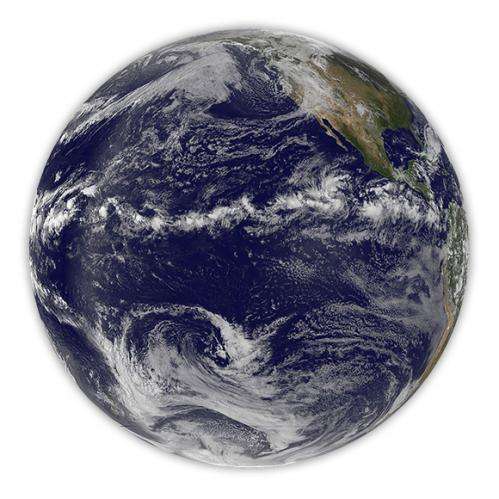Modeling challenges doused in simulations of important precipitation features

Being all wet was exactly the approach for scientists looking to piece together precipitation puzzles. New research led by scientists at Pacific Northwest National Laboratory investigated the reasons behind long-standing biases in climate models that depict a key climate feature known as the Intertropical Convergence Zone, or ITCZ. This feature is fueled by thermal energy in the tropics and forces warm, moist air to rise and dump rain over the tropics, and subsequently move toward the Earth's poles, descend and dry the subtropics.
The researchers teased out climate models' inclinations using a simplified, all-ocean planet model to depict climate precipitation features without the complications of real-world factors such as land masses and mountains. In an all-wet world, researchers could focus on larger samples of data to establish the model's statistical muscle in depicting the ITCZ and extreme precipitation.
"We found the feedbacks between convection and the atmospheric circulation amplify small differences in simulating atmospheric moisture," said Dr. L. Ruby Leung, the PNNL atmospheric researcher and project lead of two papers on the topic published in the Journal of Climate. "This results in a single versus double ITCZ, and highlights how changes in model resolution and dynamical representation can produce very different results."
The researchers also found that models' extreme precipitation simulations are very sensitive to how well they depict the motion of rising air.
Precipitation—the main source of fresh water over land—has both scientific and societal significance. Uneven distribution of precipitation in space and time can lead to floods and droughts that challenge society. Understanding how precipitation is intimately tied to the energy that drives weather and climate is the scientific challenge. Enormous, complex systems such as the climate are studied through simulations that represent our understanding of the climate system as a whole. Scientists in this study are working to understand model biases in simulating different characteristics of precipitation. Climate models have long had difficulties simulating some of the most basic precipitation features, such as the tropical rain belt or ITCZ, and extreme precipitation generated by intense storms. By simulating in an all-water world, the researchers are able to better understand how well the model represents these features, and apply those lessons to whole-system models. Uncovering these simulation issues will ultimately improve scientific climate predictions and inform societies where and when the rain will fall.
Researchers at three national laboratories, PNNL, Los Alamos National Laboratory and Sandia National Laboratories, sought to understand model biases in simulating extreme precipitation and the ITCZ's structure. The team generated a suite of simulations for an all-ocean planet using the Community Atmosphere Model (CAM) and evaluated how the simulations are sensitive to the representations of the atmosphere's dynamics and the model's resolution.
For extreme precipitation, they performed a moisture budget analysis to determine what processes are most sensitive to model representations and resolution. For the ITCZ structure, they analyzed processes associated with convection and tropical waves to narrow down why some models produce a double instead of a single ITCZ. They identified the primary source of moisture that feeds extreme precipitation: convergence from vertical transport of moisture. They showed that models running at different spatial resolutions can produce drastically different vertical motion, leading to significant differences in simulating heavy precipitation.
To determine if the insights gained from analysis of simulations over an all-ocean planet apply to what happens in the real world, the researchers are extending their analysis to a suite of atmospheric simulations with real-world settings. The team will also investigate the implications of model precipitation biases to climate change projections.
More information: Yang Q, LR Leung, SA Rauscher, TD Ringler and MA Taylor. 2014. "Atmospheric Moisture Budget and Spatial Resolution Dependence of Precipitation Extremes in Aqua-Planet Simulations." Journal of Climate, early online. DOI: 10.1175/JCLI-D-13-00468.1.
Landu K, LR Leung, S Hagos, V Vinoj, S Rauscher, T Ringler and M Taylor. 2014. "The Dependence of ITCZ Structure on Model Resolution and Dynamical Core in Aqua-Planet Simulations." Journal of Climate, early online. DOI: 10.1175/JCLI-D-13-00269.1.
Journal information: Journal of Climate
Provided by Pacific Northwest National Laboratory

















